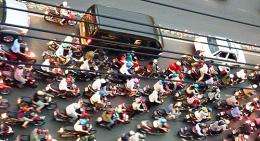No method in traffic madness

Tourists often assume the chaos on Vietnam's roads does not translate to a high crash rate. Nothing could be further from the truth, writes Anna Hollows.
Anyone who has visited Vietnam knows it is a country on the move. The streets are teeming with cars and motorcycles loaded with people, furniture, animals. Crossing the road is a scary experience.
Many tourists to the big cities such as Hanoi, where I recently spent a month working, express surprise that there are not more traffic accidents. As an outsider, it does appear that the haphazard and chaotic road system seems to work. But there are accidents. Lots of them.
Last year 11,395 people were killed in traffic accidents in Vietnam and 48,734 people were injured, according to the Vietnam National Committee for Traffic Safety. But the actual figures are likely to be higher due to the difficulty of data reporting in many areas.
I spent my time in Vietnam volunteering as a nurse in the emergency department and orthopedic ward of Viet Duc Hospital, one of the busiest medical centres in the country.
Two weeks in a Vietnamese hospital was an education in itself. I spent time in the busy triage area, the important first point of contact for the hundreds of patients who arrive at the hospital each day. About 80 percent of the cases I saw were caused by traffic accidents, with motorbike riders and pedestrians the most commonly and severely injured.
On the first day I was there a teenage couple was rushed in. They had been involved in a motorcycle accident. The girl had obvious severe facial injuries, so she received a lot of immediate attention. Once she was stabilised, we realised the boy was bleeding from his ears. A scan revealed a cerebral haemorrhage, so we did what we could to help prepare him for surgery. That is what it is like all the time in the hospital, as case after case comes through the door.
My advice to anyone travelling in Vietnam is: do not get on a motorbike. And if you do, make sure you bring a helmet from Australia. The ones worn by most of the locals are little more than upturned ice-cream buckets.
While many Vietnamese helmets might be below Australian standards, the skills and commitment of the amazing local medical staff are second to none. I was in awe of the way my colleagues were able to deal with such overwhelming workload.
It was this mix of talent and determination that attracted my father, Fred Hollows, to Vietnam 20 years ago. He met local doctors who were keen to learn modern cataract surgery. When dad died in 1993, the Fred Hollows Foundation kept his promise to deliver training. The doctors that were trained have now gone on to teach hundreds of others. Back in 1992, just 1000 modern cataract operations were being performed annually. Today, more than 160,000 are carried out each year.
The amazing improvement is due to many factors, but above all it's that local commitment and determination which is on display in hospitals right across the country. Doctors and nurses are working in conditions that you would never see in Australia. But still they manage to do the best they can, and to do it day after day.
So next time you are travelling somewhere like Vietnam, marvelling at how the traffic seems to just work, remember that this is not necessarily the case. Despite appearances, there are bad accidents every day and each day lives are saved by skilful Vietnamese medical staff. Please try not to add yourself to their workload.
Provided by University of Sydney

















